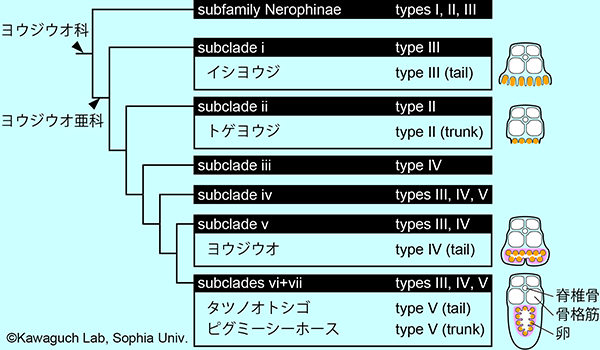Evolution of brood pouches in syngnathids
Histological observation of brood pouches
Most of the species in Syngnathidae, in which seahorses and pipefishes belong, inhabit seaweed beds or coral reefs. These species have developed brood pouches in their male fishes, and protect embryos from predators. During evolution, the morphology of the brood pouches diversified, ranging from simple open brood pouches with eggs attached to the body surface to closed brood pouches that cover the eggs with skin folds extended from both sides of the body. The most developed sacs are found in seahorses.
In this study, histological observation of brood pouches was performed using five species belonging to the family Syngnathidae. As a result, it was revealed that blood vessels were well-developed in the brood pouches of all the examined fishes. In addition, since the inner epithelium of the brood pouch is much thinner during the brooding period than in the non-brooding period, it is thought that material exchange between the father and offspring becomes easier during incubation.

Fig. 1: Phylogenetic relationships of Syngnathidae. Please see original Figure 1 in English.
Another feature of this study is that we clarified the morphology of the brood pouch of the pygmy seahorse. In the genus Hippocampus, there are "large" species with a body length of about 24-350 mm, and "small" species with a very small body size (13.6-26 mm in length). These "small" species form a phylogenetically separate group from the "large" species and are called pygmy seahorses. In addition to body size, the morphology of brood pouches also differs between them. "Large" species have brood pouches on the surface of the tail, whereas pygmy seahorses possess within the body cavity. Histological observation revealed that the pygmy seahorse also possesses a placenta, and other histological features were similar to the other seahorses. Based on these results, we concluded that the pygmy seahorse pouch was originally present in the tail, but was repositioned to the trunk due to selection for diminutive size.
Original Paper
- Akari Harada, Ryotaro Shiota, Ryohei Okubo, Makiko Yorifuji, Atsushi Sogabe, Hiroyuki, Motomura, Junya Hiroi, Shigeki Yasumasu, and Mari Kawaguchi. (2022) Brood pouch evolution in pipefish and seahorse based on histological observation. Placenta, 120: 88-96.
DOI: 10.1016/j.placenta.2022.02.014